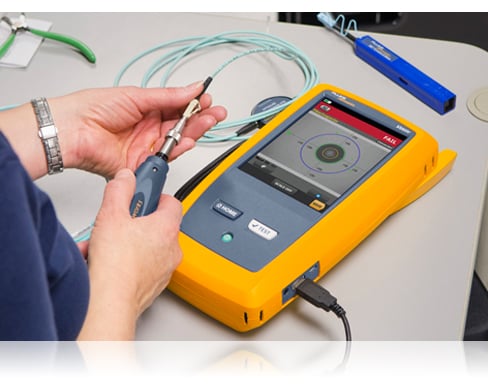The Role of Optical Fibre Testing in Ensuring Quality and Effectiveness in Connection Solutions
In today's swiftly evolving digital landscape, the significance of optical fibre testing can not be overstated, as it functions as a foundation for making certain the top quality and efficiency of connectivity solutions. By employing a variety of screening techniques, consisting of OTDR and loss analyses, organizations can proactively identify and alleviate possible network concerns that may hinder performance. Furthermore, routine screening not only lines up with industry requirements but also leads the way for boosted information transmission. As innovation proceeds to advancement, the future of optical fibre screening presents fascinating obstacles and possibilities that merit closer evaluation.
Relevance of Optical Fibre Screening
The importance of optical fibre screening can not be overstated in making certain the stability and efficiency of communication networks. As the foundation of modern-day telecommunications, optical fibers help with high-speed information transmission, making their dependability critical to functional success. Evaluating acts as a positive step to recognize prospective concerns such as signal loss, attenuation, and physical damages, which can endanger network performance.
Normal screening permits the verification of setup top quality and the discovery of defects that might influence information integrity - fibre testing equipment. By using rigorous testing procedures, network drivers can mitigate the risks connected with network failures, consisting of downtime and financial losses. In addition, optical fibre screening guarantees conformity with market standards and laws, improving the overall top quality of service offered to end-users.
Ultimately, the methodical assessment of optical fibres adds to the durability and effectiveness of communication systems. It allows stakeholders to make educated decisions pertaining to maintenance, upgrades, and troubleshooting. In a landscape where data is progressively vital, focusing on optical fiber screening is vital to sustaining durable and reliable connectivity solutions, therefore supporting the demands of modern electronic settings.
Kinds of Optical Fiber Examinations
Numerous testing techniques are used to make sure the performance and integrity of optical fibres within interaction networks. These examinations can be broadly categorized into 2 primary kinds: installation tests and upkeep tests.
Installment tests are conducted instantly after the installment of optical fiber wires to confirm their performance and integrity - robotic vision. One of the most typical installation examinations consist of Optical Time-Domain Reflectometry (OTDR) tests, which assess the high quality of the fibre by recognizing faults or breaks, and end-to-end loss examinations, which determine the complete optical loss from one end of the fibre to the other
Upkeep tests, on the other hand, are done periodically to ensure ongoing efficiency and find prospective problems gradually. These include visual inspection, which checks for physical problems or inappropriate setups, and connection examinations, which confirm that the signal can travel through the fiber without interruption.
Furthermore, progressed examinations such as Polarization Mode Dispersion (PMD) and Chromatic Diffusion (CD) tests can be performed to evaluate the fiber's efficiency under different problems. By employing these varied testing techniques, service technicians can preserve high criteria of quality and reliability in optical fibre networks.
Advantages of Normal Examining
Regular testing of optical fibres plays a vital duty in maintaining the general efficiency and integrity of communication networks. By conducting normal assessments, companies can guarantee that their fiber optic installments satisfy sector standards and run efficiently. This aggressive method aids to determine potential weak points and destruction gradually, permitting prompt interventions before problems intensify.

Cost-effectiveness is another benefit. By resolving small issues early, companies can stay clear of the high prices related to major repair work or system failures. Normal testing likewise fosters compliance with regulatory needs, making certain that the network follows needed security and efficiency standards.
Typical Concerns Determined
Recognizing typical issues in optical fibre networks is essential for preserving optimum performance and integrity. Different variables can add to disturbances, including physical damage, inadequate installation techniques, and environmental influences.
Physical damages, such as bends, breaks, or abrasions, can considerably weaken signal quality. Inappropriate installation methods, consisting of extreme stress or inadequate safeguarding of cords, might cause increased depletion and loss of connectivity. In addition, environmental aspects such as temperature level fluctuations, dampness ingress, and rodent disturbance can endanger the honesty of the fibre.
Adapter issues additionally frequently develop, with improper positioning or contamination causing raised insertion loss. Splicing errors can introduce considerable signal deterioration if not executed with precision.

Dealing with these common concerns with routine optical fibre screening not only enhances network reliability yet likewise enhances overall performance, guaranteeing that connectivity services remain robust and efficient.
Future Patterns in Testing
As the need for high-speed connection remains to rise, the future of optical fiber testing will significantly concentrate on automation and advanced analytics. The assimilation of synthetic knowledge (AI) and equipment understanding (ML) in screening processes will certainly make it possible for more efficient information evaluation and anticipating upkeep, decreasing downtime Visit This Link and enhancing general network reliability. Automated testing options will certainly enhance the examination and accreditation of fiber networks, minimizing human error and increasing testing throughput.
One more significant fad is the fostering of remote screening technologies. As the release of fiber networks increases right into remote and underserved locations, remote screening capacities will certainly allow technicians to monitor and detect network problems without physical presence, thereby lowering operational costs and boosting feedback times.
In addition, there will be a change in the direction of more thorough screening standards that include not only typical loss measurements but also performance metrics such as latency and bandwidth use. This holistic technique will certainly facilitate better network management and optimization strategies.
As these trends progress, the optical fibre testing landscape will certainly not only boost the high quality and efficiency of connectivity services yet also sustain the growing complexities of modern-day communication networks.
Verdict
To conclude, optical fiber testing serves as a basic part in maintaining the stability and performance of interaction networks. By systematically examining various parameters through developed testing approaches, potential issues are determined and Recommended Site fixed, ensuring ideal performance. The ongoing commitment to regular testing not just improves information transmission but additionally straightens with sector standards, fostering reliability in network frameworks. As modern technology progresses, the significance of innovative testing methods will continue to grow, further progressing connection options.